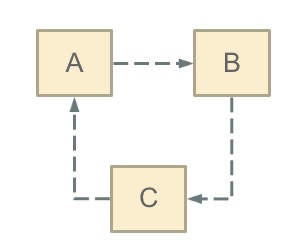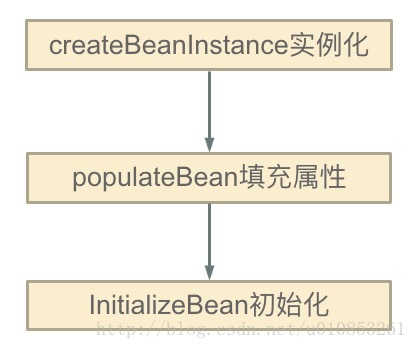
public class StudentA { private StudentB studentB ; public void setStudentB(StudentB studentB) { this.studentB = studentB; } public StudentA() { } public StudentA(StudentB studentB) { this.studentB = studentB; } }
public class StudentB { private StudentC studentC ; public void setStudentC(StudentC studentC) { this.studentC = studentC; } public StudentB() { } public StudentB(StudentC studentC) { this.studentC = studentC; } }
public class StudentC { private StudentA studentA ; public void setStudentA(StudentA studentA) { this.studentA = studentA; } public StudentC() { } public StudentC(StudentA studentA) { this.studentA = studentA; } }
上面是很基本的3个类,,StudentA有参构造是StudentB。StudentB的有参构造是StudentC,StudentC的有参构造是StudentA ,这样就产生了一个循环依赖的情况,
我们都把这三个Bean交给Spring管理,并用有参构造实例化
<bean id="a" class="com.liuqing.student.StudentA"> <constructor-arg index="0" ref="b"></constructor-arg> </bean> <bean id="b" class="com.liuqing.student.StudentB"> <constructor-arg index="0" ref="c"></constructor-arg> </bean> <bean id="c" class="com.liuqing.student.StudentC"> <constructor-arg index="0" ref="a"></constructor-arg> </bean>
下面是测试类:
public class Test { public static void main(String[] args) { ApplicationContext context = new ClassPathXmlApplicationContext("com/liuqing/student/applicationContext.xml"); //System.out.println(context.getBean("a", StudentA.class)); } }
执行结果报错信息为:
Caused by: org.springframework.beans.factory.BeanCurrentlyInCreationException:
Error creating bean with name 'a': Requested bean is currently in creation: Is there an unresolvable circular reference?
2、setter方式单例,默认方式
Spring中Bean实例化的图
如图中前两步骤得知:Spring是先将Bean对象实例化【依赖无参构造函数】--->再设置对象属性的
<!--scope="singleton"(默认就是单例方式) --> <bean id="a" class="com.liuqing.student.StudentA" scope="singleton"> <property name="studentB" ref="b"></property> </bean> <bean id="b" class="com.liuqing.student.StudentB" scope="singleton"> <property name="studentC" ref="c"></property> </bean> <bean id="c" class="com.liuqing.student.StudentC" scope="singleton"> <property name="studentA" ref="a"></property> </bean>
下面是测试类:
public class Test { public static void main(String[] args) { ApplicationContext context = new ClassPathXmlApplicationContext("com/liuqing/student/applicationContext.xml"); System.out.println(context.getBean("a", StudentA.class)); } }
打印结果为:
com.liuqing.student.StudentA@1fbfd6
我们结合上面那张图看,Spring先是用构造实例化Bean对象 ,此时Spring会将这个实例化结束的对象放到一个Map中,并且Spring提供了获取这个未设置属性的实例化对象引用的方法。 结合我们的实例来看,,当Spring实例化了StudentA、StudentB、StudentC后,紧接着会去设置对象的属性,此时StudentA依赖StudentB,就会去Map中取出存在里面的单例StudentB对象,以此类推,不会出来循环的问题
3、setter方式原型,prototype
修改配置文件为:
<bean id="a" class="com.liuqing.student.StudentA" scope="prototype"> <property name="studentB" ref="b"></property> </bean> <bean id="b" class="com.liuqing.student.StudentB" scope="prototype"> <property name="studentC" ref="c"></property> </bean> <bean id="c" class="com.liuqing.student.StudentC" scope="prototype"> <property name="studentA" ref="a"></property> </bean>
scope="prototype" 意思是 每次请求都会创建一个实例对象。两者的区别是:有状态的bean都使用Prototype作用域,无状态的一般都使用singleton单例作用域。
测试用例:
public class Test { public static void main(String[] args) { ApplicationContext context = new ClassPathXmlApplicationContext("com/liuqing/student/applicationContext.xml"); //此时必须要获取Spring管理的实例,因为现在scope="prototype" 只有请求获取的时候才会实例化对象 System.out.println(context.getBean("a", StudentA.class)); } }
打印结果:
Caused by: org.springframework.beans.factory.BeanCurrentlyInCreationException:
Error creating bean with name 'a': Requested bean is currently in creation: Is there an unresolvable circular reference?
对于“prototype”作用域Bean,Spring容器无法完成依赖注入,因为“prototype”作用域的Bean,Spring容器不进行缓存,因此无法提前暴露一个创建中的Bean。
四、Spring怎么解决循环依赖

singletonFactories : 单例对象工厂的cache






【推荐】国内首个AI IDE,深度理解中文开发场景,立即下载体验Trae
【推荐】编程新体验,更懂你的AI,立即体验豆包MarsCode编程助手
【推荐】抖音旗下AI助手豆包,你的智能百科全书,全免费不限次数
【推荐】轻量又高性能的 SSH 工具 IShell:AI 加持,快人一步
· go语言实现终端里的倒计时
· 如何编写易于单元测试的代码
· 10年+ .NET Coder 心语,封装的思维:从隐藏、稳定开始理解其本质意义
· .NET Core 中如何实现缓存的预热?
· 从 HTTP 原因短语缺失研究 HTTP/2 和 HTTP/3 的设计差异
· 分享一个免费、快速、无限量使用的满血 DeepSeek R1 模型,支持深度思考和联网搜索!
· 基于 Docker 搭建 FRP 内网穿透开源项目(很简单哒)
· ollama系列01:轻松3步本地部署deepseek,普通电脑可用
· 按钮权限的设计及实现
· 25岁的心里话